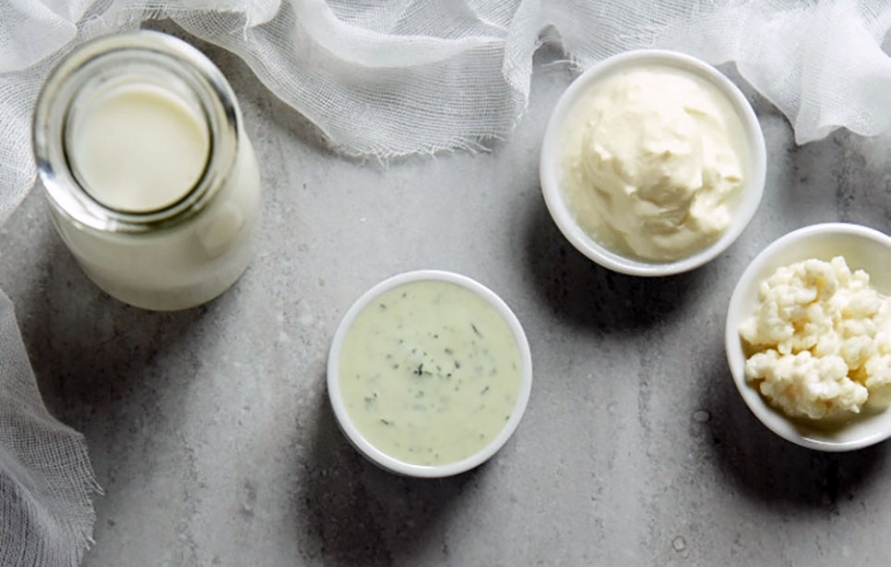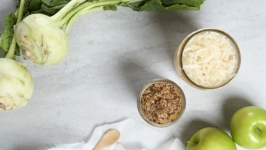About this recipe
Kefir’s unique microbial composition has advantages over other cultured dairy products such as yogurt. Yeasts present in finished kefir colonize in the gut (yogurt cultures, on the other hand, are transient) and help to inhibit the growth of pathogenic fungi like Candida. Many of the bacterial strains in kefir are closely related to cultures found in raw dairy and colonize the gastrointestinal tract as well, contributing to healthy flora. The cultures’ likeness to that of raw dairy also makes kefir an excellent culture choice for cheesemaking.
When kefir grains are added to milk, Lactobacillus and other types of bacteria present in the grains metabolize lactose into lactic acid, thus decreasing the pH. Other friendly bacteria, such as propionibacteria, break down lactic acid into propionic acid and slow-fermenting yeasts also metabolize lactose into ethanol and carbon dioxide. The work of these micro-organisms create an environment that prevents the growth of harmful bacteria and molds, giving finished kefir a relatively long shelf life of about 30 days. These compounds are also responsible for kefir’s tangy flavour and slightly effervescent qualities.
Fermenting milk with kefir grains is one of the simplest ways to culture dairy. There is no need to precisely regulate temperature, as kefir is a mesophilic culture, meaning it functions optimally at room temperatures. Because the starter cultures are contained in the grains, the starter can easily be separated from finished kefir and used to culture successive batches. Perhaps the most challenging aspect is acquiring the grains in the first place.
1 glass jar, appropriately sized (leave a bit of headroom for expansion of the milk)
1 non-metallic spatula
1 non-metallic strainer or colander
1 small square of cheesecloth
1 elastic band
1 teaspoon kefir grains per 1 cup high quality full fat milk, preferably organic (must not be lactose-free or ultra-high temperature pasteurized)
This is more of a rough guideline, so the amounts needn’t be exact. Try to approximate this ratio as closely as possible for the best results, and try not to exceed ¼ cup of grains per litre of milk. Overcrowding the grains means a smaller food supply for the cultures and can impact the finished product, as well as the overall health of the grains.
Put the grains in the glass jar and add the milk. Loosely cover the jar with cheesecloth and secure with the elastic band. Place the jar out of direct light, in a room temperature location. Ferment for about 24 hours or until desirably soured.
Using the strainer or colander, strain the kefir into a glass or bowl and use the spatula to shift the grains around the strainer to extract all the kefir. Wash the jar. Return the grains to the jar and top up with fresh milk. The kefir can be consumed as is, used in various preparations or it can be fermented for another day without the grains, to improve the flavour. The optional secondary fermentation mellows some of the acidity and increases the effervescence. This step also increases the nutrient and bacterial content, while reducing the lactose content.
This cycle of culturing, straining and re-culturing becomes part of a daily routine. The grains will last a lifetime if properly fed and nurtured, and will even multiply over time. Share the excess grains.
If the grains cannot be cared for on a daily basis, they can be made semi-dormant by placing them in the refrigerator with fresh milk. They will keep partially suspended in the fridge for a week — change the milk after a week if the grains are to be kept dormant for longer. For even longer-term storage, the grains can be either dehydrated or frozen.
Kefir Ranch
Though many of us would rather not admit it, ranch dressing is good. It’s a nostalgic good-on-everything kind of guilty pleasure. Ditch the overly processed ingredients along with the guilt and make this kefir-based ranch loaded with beneficial cultures.
2 cups kefir, strained*
4 tablespoons kefir crème fraiche or sour cream
1 garlic clove, finely minced (use a microplane or garlic press)
1 tablespoon lemon juice
1 teaspoon sea salt
1 teaspoon black pepper
1 tablespoon minced parsley
1 tablespoon minced chives
1 tablespoon minced dill
In a bowl, thoroughly mix all the ingredients and let stand for 1 hour for the flavours to blend. Taste the dressing and season as required. Store in the refridgerator up to a few weeks.
*To strain kefir, line a fine mesh strainer with a bit of cheesecloth and place over a deep bowl. Pour the kefir into the strainer, place in the refrigerator, and strain anywhere from 8 to 24 hours. The length of time is dependent on the initial thickness and fermented nature of the kefir being used — a yogurt-like thickness or slightly thinner is ideal. Use the strained kefir for recipes and reserve the leftover whey for other uses.






